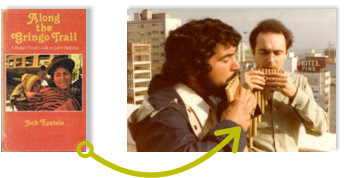Brazil. The good, the bad, and the ugliest.
Brazil: The Good, The Bad, and The Ugly
There were heavily armed soldiers, curfews, and an intimidating military presence on many street corners. In Mexico, I was tear-gassed: in El Salvador and 3 American nuns went missing the day I arrived, later to be found dead. It later became a movie. I met a guy where I was staying who said he was a correspondent for Soldier of Fortune, a magazine written for mercenaries. I avoided him from then on. It was in San Salvador that Bishop Oscar Romero, a critic of government policy, was assassinated while saying mass in March 1980. He was canonized by the Catholic church in May 2015.
My last stop before Brazil was Bolivia where I spent many weeks improving my Spanish and learning to play the charango from a master, Ernesto Cavour. I helped Ernesto with his English before he visited Rhode Island where he'd done a student exchange, and he helped me with charango lessons which sadly I abandoned after I left Bolivia. I still have 2 charangos stored away at home as family heirlooms. That, and the people and food were good. Military control and coups were bad with heavily armed soldiers everywhere. Changes of government and power happened on average about the length of gestation period in Bolivia, and democracy seemed forever in a breech position. I left when another coup was festering. Indeed a conservative stranger told me another was underway when I was at the railway station ready to leave Bolivia, and the heights of the Andes.
My first stopover was in Santa Cruz, a lowland city that then had a large Amish community. Then it was boarding a large comfortable train for the long and tiring trip to Brazil. This train was dubbed "el tren de los muertos" or train of the dead, perhaps as the trip was over 30 hours duration, and yes we were dead-tired upon arrival in San Paulo. Unknown to many is that neither San Paulo nor Rio are the capitals of this vast country. Due to intercity rivalry, Brasilia is the capital. Paulistas mock Cariocas and visa versa. Such is the case in many countries where the capital city is not the major city in size or renown.
On this trip, I befriended a Brazilian freelance photojournalist who had interviewed and photographed the female president before her government was overthrown. I can't remember his name but we remained in contact during all my time in Brazil and he invited me to a theatrical performance of The Pied Piper of Hamelin, a play with a satirical twist. There was a powerful song popular then about the fate of people who had to abandon the countryside for large cities such as São Paulo and Rio. Enter the favelas, or shanty towns which are a blight on Brazil even today. Definitely bad and ugly.
People I met said that I spoke Portanol but I replied I spoke Espanuese or dominant Spanish with a tiny bit of Portuguese in the mix. It helped.
Brazilians are warm, friendly people: diverse in ethnic backgrounds and colour, have rhythm, are sporty, love dancing, and are very welcoming. You have to love Brazilians who have grace, beauty, and style. They won my heart and are definitely The Good. The armed forces that dangerously lurk in the shadows not so much. Bolsinaro The Ugliest, just like the Favela pictured below. These slums are often much worse in this land of startling contrasts and are often constructed from whatever waste one can scrounge to put a roof over the family's head. Often favela dwellers are families descending into large cities after being evicted from rural communities. It's out of The Grapes of Wrath in the 1930s. No grace just a big disgrace.
Arrival in São Paulo
The train ends its long journey at the São Paulo terminal at about the start of the Summer Moscow Olympics on July 19th. Enter the remarkable Vito Comar, a best friend from our Perth university, and later my Sydney days.
Vito has lived in Brazil for a few years now and seems to speak perfect Portuguese but with a nasal drawling quality. Wrong, on TV the entire country speaks this way. He takes me back to his temporary accommodation at the time which is a world removed from any favela. It is an ultra-modern, very tall apartment block in the posh part of town and very central, all replete with a concierge, elevators, and gleaming glass tower block. The skyline is modern, but It was like living in a bubble as it was far removed from the dreary lives of those living in out-of-sight favelas, and dangerous neighbourhoods due to living pressure.
City of God (20120 was a famous Brazilian movie that was nominated for 4 Oscars in 2004. See review. It was about crime in Rio shantytowns. The bad and the ugly. There was a beautiful song, popular at the time of my visit, bewailing the fate of the rural exodus to cities ending up in favelas. People I met played it constantly. My photojournalist friend invited me to a place that included music lessons, and this wonderful song that empathised with the poor and downtrodden was a part of that scene. Music flows richly amongst the Brazilian people, as the world knows, who are quick to get up and dance, which is more than good.
I had landed on my feet. These "digs" belong to an elderly Texan woman then living in Brazil who is a Bahai, a faith Vito has joined and still practices. I met her briefly before she went off somewhere, and shortly after Vito arranged for me to stay with friends, a delightful couple with whom I spent my remaining 10 happy weeks in that city. São Paulo is/was divided into A B C and D districts and I was in the C area. It was a good area to live in and I met some lovely and friendly people there. On any trip into central São Paulo, the favelas stand out like a sore thumb: a dark stain on the soul of Brazil.
Talking about national divisions: it soon became obvious that there is a great intercity rivalry between the two major cities of Brazil or Brasil as they spell it, and São Paulo and Rio, which is why Brasilia is the capital of Brasil. Paulistas bemoan Cariocas and visa vera. There's nothing new in this: Canberra, Washington and Ottawa. Bonn, the birthplace of Beethoven, was the capital of West Germany
I had just arrived when a friend of Vito's had a crisis with her daughter hospitalised for a drug overdose. I spent my second night entirely in that hospital where I was briefly questioned by the local constabulary in a routine way. I was soon a bit puzzled by the different uniforms of the various arms of the police: a bit like Italy. But it was a large good hospital like any other in the world with staff rushing about the wards attending to patients. I was the new arrival on the block soaking it all in.
My host in the C district was Sergio, a photographer, and his Swiss partner whose name I don't recall, but she left for a trip to her native Switzerland about midway through my stay. The guy on the far right in music photo is Sergio. It was a warm and friendly household, with neighbours and friends popping in daily and music ruling the airwaves. I insisted on paying a token rent and was comfortable in a sleeping bag and mattress in the garage.
A new friend took me to a soccer game which was quite a hoot, or should that be boot? His team was Corinthians and he was all decked out in their colours. We were seated amongst rival team supporters which made him uncomfortable, but when the game got underway it seemed more interesting to watch rival team supporters taunting each other, throwing smoke bombs, and generally making an interesting scene fit for television. It was all colour and sound and there wasn't a silent moment in the match. I can't remember the scoreboard and wonder how many fans watched the match anyway.
Vito and I went to Rio for a long weekend. We stayed with friends and did the usual: from street markets, the statue of Christ on Corvavo, and Copacabana Beach. On Copacabana Beach, we befriended a young woman who was an air hostess with a Brazilian airline. It was sad when she recounted her life just off one of the world's most famous beaches. She was very confused and not at all happy. And so it goes.
I remember a young woman I met and went out with a few times. She was of Italian origin and interestingly we got around on her Lambretta. We went to a movie, the first Star Wars movie arriving late but just waited for the film to repeat from the beginning. Time keeping doesn't seem to be important in Brazil, but I recall the same cinema experience in Los Angeles where films roll continuosly.
Vito went north in my final weeks in São Paulo and I saw him off at the bus station. At the time he was headed for Manaus, in the state of Amazonas. He got married and started a family. He also made a few trips to Australia where we caught up.
Now for another trip down memory lane. This week, early March 2022, I undertook via this blog another digital homage to Brazil, and to Vito, now living in Dourados east of São Paulo where he is a professor at the state university. He is divorced, has a loving grandson and has regular contact with his three adult children. We have spoken almost weekly in the last 20 or so months, on health issues, and he has also discussed issues important to him, namely his involvement with Guarani people in his area.
Prof. Vito wrote a report "Out of the Ashes" about a deliberately lit fire blazing through a Guarani community, and a plan to help these historically disadvantaged people. Out of this plan evolved a website at www.sharingcare22.info that is soon to be launched. Vito is an active member of IMAD, The Institute of Environment and Development in English, an NGA comprised like Vito of chiefly academics dedicated to assisting the people they are with posing with below. Where's Vito Today. Spot him below.








Comments
Post a Comment